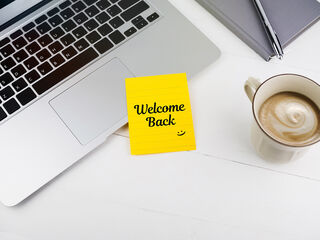Career
So Your Employer Won’t Allow You to Work From Home? Try This
10 ways to bring your positive remote experience to work.
Posted July 9, 2021 Reviewed by Davia Sills
Key points
- Many employees are reluctant to return to working full-time in the office after getting used to working remotely.
- If employers insist on a return to in-office work, employees can benefit from some of the lessons they learned working from home.
- Making the office more comfortable, taking regular breaks throughout the day, and setting clear boundaries between work and home can help.
If you found working from home a dreamy escape from a 9 to 5 sentence, but your employer is soon ending the practice—all is not lost. Of course, you can look for greener, “more remote pastures.” But there are also steps you can now take at your job to incorporate some of the telecommuting aspects you came to know and love. Your own hybrid of sorts. This can alleviate stress, not only as you make the transition but long term in your career.

First, realize you’re not alone. Nearly 40 percent of workers would consider quitting if their bosses required them to return to work full-time, according to a FlexJobs survey released in May 2021. But the sad truth is that only about 10 percent of jobs on popular hiring platforms include remote work. And between now and September, about 30-50 percent of employers are already bringing back their long-lost staff to the trenches, according to most industry reports. That is if the Delta variant of COVID-19 doesn’t become yet another game-changer.
How can you import the best of your remote experience into your office to bring you greater peace of mind, now and in the future? Consider these tips:
1. A focused life ahead
Remember how you had periods of impeccable productivity? Yes, there was Zoom fatigue and other distractions at times. But you had to be disciplined as you maintained communications with the office. You weren’t weighed down by errant office distractions or flustered by all the office “noise." You had to be focused, accountable, and hone serious time management skills against life’s demands during a life-changing pandemic.
Because you saw how those periods of intense concentration enhanced your productivity, you will likely avoid squandering valuable time at the office. You’ll work smarter and faster, aware of the rewards. You’ll get home earlier or expand your free time, offering a better work/life balance. Right—exactly what remote work gave you.
2. Alone and happy, thank you very much
Collaboration is great, and that’s one of the things workers did miss most about the office. But how much is enough? You may have more of a say upon your return that working quietly and independently is a boost to productivity. Perhaps now you realize how much you can accomplish with fewer meetings!
Consider how this can be transferred into your job. You and your team might be able to initiate a Quiet Hour or two during the day to your general work area. Other options include using a headset at the noisiest times of the day or a vacant office to create your own quiet space. These practices may not replace remote work, but if they give you a similar feeling of solace, even for short stretches, they’re worth trying.
3. How comfy is your office area?
You and fellow coworkers may have some suggestions on how your physical space can better boost productivity in a more user-friendly way for the team. If your boss is open-minded, you may get traction on suggesting a more relaxed, congenial atmosphere—whatever that may look like. Aside from making spaces more accommodating for flexible work schedules, many firms are considering making their spaces more “homey” or hotel-like. They’re considering everything from better lighting to more comfortable furniture and more art—essentially a less sterile workplace.
4. Offer general “remote at work” feedback to your manager.
Clearly, you’re not the only one returning to work who longs for an idyllic WFH environment. Consider talking to a few colleagues who share your sentiment about incorporating positive work-from-home aspects into the office. Get their support for offering input to your manager, as there’s power in numbers. Most employers are already looking at the topic and may welcome the initiative.
Employers are grappling with Delta variant, health and legal concerns, social distancing, mask-wearing, and more. There are a plethora of topics related to the transition now being addressed from a human resources standpoint. The remote work topic is particularly sensitive and can cause much rancor. Feedback like this could lead to a departmental forum... and your input might also be shared with HR.
5. Disguise your office.
Even if you can’t impact the physical area of your department or general group area, you can do so in your own personal space. Make it comfortable. Consider adding pictures that evoke great memories or plants and flowers that create calm. A lamp with warm lighting can go a long way, too. You don’t have to break the bank to make a pleasant impact that’s reminiscent of home.
6. Congrats: You’ve joined the Zoom Technorati.
Zoom (or your favorite video conference platform) is not just for remote work anymore. If you were slow to get on the bandwagon, your WFH experience put you on the fast track. Now you can leverage these skills and take them a step further, using their finer features. You may now find document sharing or session recordings irresistible daily tools. They may even trump regular, in-person meetings—with attendees who might work on the same floor.
7. Be comfortable but professional in your wardrobe.
What you wear translates directly to how you feel. That’s not to say you should show up in sweats—or at the extreme, invest in an entirely new coming-out party wardrobe! But if the dress code is casual, such as jeans, take advantage. It will bring more relaxation to your day. Comfort is the watchword in fashion now, and it can be achieved while looking professional. A wardrobe or accessory updates, like nice shoes, classy belts, and jewelry, can accent a casual look at work cost-effectively.
8. Stop making your office a marathon.
At home, there were opportunities to take breaks, as your boss and coworkers weren’t watching over you. You weren’t worried about face time either, and that freed your mind to focus on problem solving and results. Now it may be tempting to fall back into a routine of nonstop work after a 1.5-year absence.
Workaholism is often considered a badge of honor and rewarded in our culture, but eventually, it follows the law of diminishing returns. Resist the temptation. Remember what kept you sane at home; you created balance. This is likely another reason you really enjoyed remote work!
9. Deploy some boundary setting.
Prioritize your work and encourage those around you to do so, too. Learn to say “no” if your end product and health starts to suffer due to an unreasonable workload by managing up. Make sure you stand your ground if you’re becoming a doormat to coworkers or badly behaving managers.
10. Inject a little fun and self-care.
Remember during the heart of the pandemic the emphasis on re-evaluating the bigger meaning of life and happiness? Here’s an opportunity to put that broader perspective into practice. It takes discipline to stay mindful of your own needs, reduce stress, and block out all interpersonal issues that don’t serve you—but it’s a worthwhile pursuit.
Look for ways to inject humor into your conversations and meetings at your job. During breaks or more transactional tasks, think about self-care. Use earbuds to listen to your favorite playlist. Remember to take walks and stretch every 15 minutes. Take deep breaths throughout the day and stay hydrated. It’s easy to fall back into old work habits.
Taking these steps may not recreate the remote work utopia to which you became accustomed. But they may help glean the best from the experience, leading to greater happiness and self-esteem—no matter where your career takes you.




